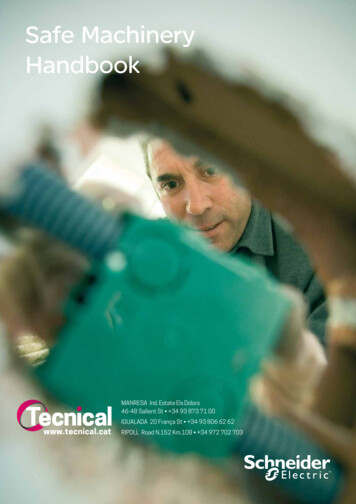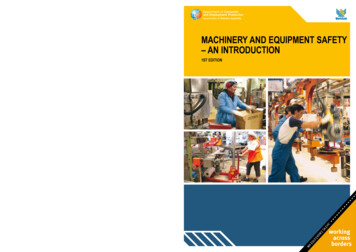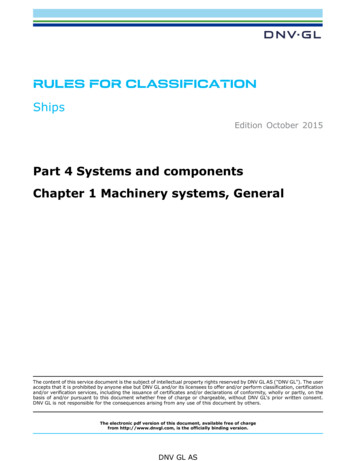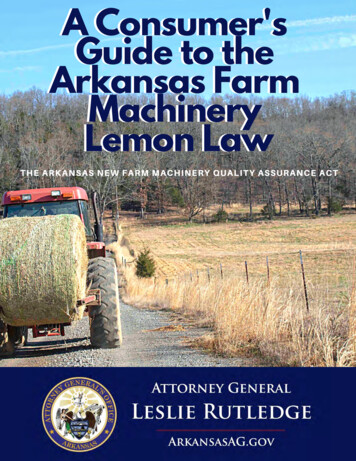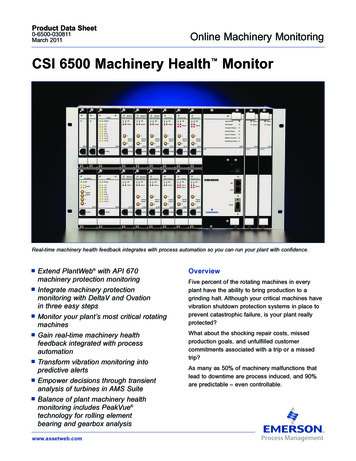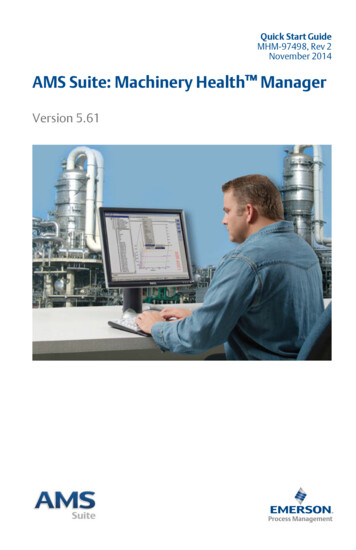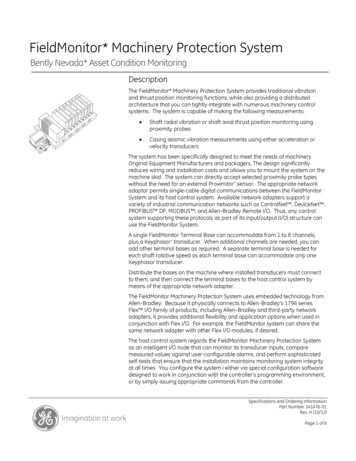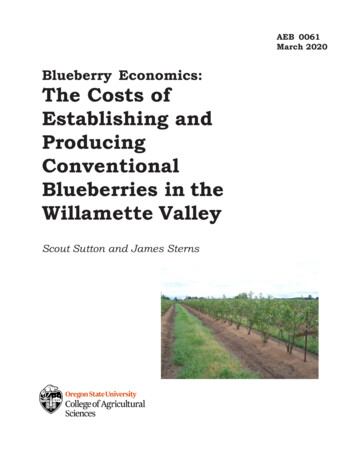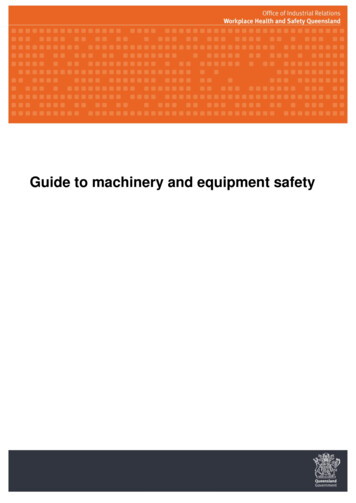
Transcription
Guide to machinery and equipment safety
ContentsIntroduction . 3Consulting workers and workplace health and safety representatives . 31.Key principles of machinery and equipment safety . 41.1Mechanical hazards . 41.2Non-mechanical hazards . 51.3Access hazards . 6Access. 62.Risk control of machinery and equipment hazards . 92.1Risk control of general hazards . 92.2Risk control of mechanical hazards . 10Guarding . 10Other mechanical hazard risk control options . 132.3Risk control of non-mechanical hazards . 15Personal protective equipment. 162.4Risk control of access hazards . 16Working at height . 17Lockout tagout: Removing and controlling energy sources during access . 18Identifying energy sources . 19De-energise stored energies . 19Isolation procedures. 19Lockout . 20Tagout . 203.Purchasing machinery and equipment list . 224.Information and guidance . 24PN10596 Version 3 Last updated January 2019 – Guide to machinery and equipment safety2
IntroductionA guide to machinery and equipment safety is provided to assist persons conducting abusiness or undertaking (PCBU) and workers to comply with their duties under theWork Health and Safety Act 2011 (the Act) and the Work Health and SafetyRegulation 2011 (the Regulation).This guide is an introduction to managing the risks associated with use of machinery andequipment in the workplace.Relevant persons can use this guide to: identify machinery and equipment hazards in the workplace eliminate or reduce the risk of those hazards causing harm.The guide will also be useful to anyone else who is interested in machinery and equipmentsafety, such as workers and Workplace Health and Safety Representatives (WHSRs).Workplace Health and Safety Queensland (WHSQ) also has additional information andguidance supporting topics introduced in this document. For further information, refer toSection 4.Consulting workers and workplace health and safetyrepresentativesConsultative processes allow people to provide input and raise potential safety concernsabout the work they undertake. Although hazards associated with machinery and equipmentare often easily identified, the ways in which people can gain access to, or may be exposedto, hazards require a detailed understanding of how they do their job.PN10596 Version 3 Last updated March 2019 – Guide to machinery and equipment safety3
1. Key principles of machinery and equipment safety1.1Mechanical hazardsMachinery and equipment have moving parts. The action of moving parts may havesufficient force in motion to cause injury to people.When assessing machinery and equipment for possible mechanical hazards, consider: machinery and equipment with moving parts that can be reached by people machinery and equipment that can eject objects (parts, components, products or wasteitems) that may strike a person with sufficient force to cause harm machinery and equipment with moving parts that can reach people, such as booms ormechanical appendages (arms) mobile machinery and equipment, such as forklifts, pallet jacks, earthmoving equipment,operated in areas where people may gain access.Common mechanical hazards and associated risks for machinery and equipment areshown below.HazardRiskRotating shafts, pullies, sprockets and gearsEntanglementHard surfaces moving togetherCrushingScissor or shear actionSeveringSharp edge – moving or stationaryCutting or puncturingCable or hose connectionsSlips, trips and falls (e.g. oil leaks)Robotic arms can reach over their base, movewith remarkable speed and high force, and cancause injury if controls to separate people frommoving plant are not implemented.Mobile plant operated in areas where people work m a ycause injury through collision. Traffic control andsegregation are forms of control.PN10596 Version 3 Last updated March 2019 – Guide to machinery and equipment safety4
1.2 Non-mechanical hazardsNon-mechanical hazards associated with machinery and equipment can include harmfulemissions, contained fluids or gas under pressure, chemicals and chemical by-products,electricity and noise, all of which can cause serious injury if not adequately controlled. Insome cases, people exposed to these hazards may not show signs of injury or illness for years.Where people are at risk of injury due to harmful emissions from machinery and equipment,the emissions should be controlled at their source.When assessing machinery and equipment for possible non-mechanical hazards, considerhow machinery and equipment can affect the area (environment) around them.Common non-mechanical hazards are shown below.Non-mechanical hazardsDustMist (vapours or fumes)Explosive or flammable atmospheresNoiseHeat (radiated or conducted)Ignition sources (flame or spark)High intensity light (laser, ultraviolet)Molten materialsHeavy metals (lead, cadmium, mercury)ChemicalsSteamPressurised fluids and gasesIonising radiation (x-rays, microwaves)ElectricalWoodworking dust generated by a buzzer isremoved via forced extraction and ventilation.Welding fumes are extracted via flexible,locatable forced extraction and ventilationsystem.PN10596 Version 3 Last updated March 2019 – Guide to machinery and equipment safety5
1.3 Access hazardsPeople must be provided with safe access that is suitable for the work they perform in, on andaround machinery and equipment. A stable work platform, suited to the nature of the workthat allows for good posture relative to the work performed, sure footing, safe environmentand fall prevention (if a fall may occur), is a basic requirement. For example, cooling towerson building roofs may have poor access, yet must be attended by a service person atpredictable times for water treatment, chemical dosing or monitoring of automated dosingequipment. People performing these tasks must be provided with the means to get themselvesand any equipment they require onto the roof with no risk, or minimal risk of fall or injury.When thinking about safe access to machinery and equipment, consider the following: who will be working on or around the machinery and equipment people who are required to work in enclosed areas where the atmosphere could beharmful, such as pits, tanks or storage vessels what equipment or materials need to be carried to undertake the task where and when is access required for operation, maintenance and cleaning how will people gain safe access (walkway, gantry, elevated work platform or ladder) what work will be carried out during access will people be near or exposed to an unidentified mechanical or non-mechanical hazard atthe time of access has consultation occurred with workers or contractors regarding how they intend to gainaccess, and what equipment and work platform or structure is best suited for the intendedtask.AccessAccess needs can be predicted and planning must occur in advance. People need access tomachinery and equipment in the workplace (either continually or occasionally) for predictabletasks such as operation, maintenance, repair, installation, service or cleaning. Access mayvary during each stage of the machinery and equipment life cycle. For example: installation or removalo complete access from every area may be required and involve disconnection orconnection of services, such as water, air, pipes, installation of electrical cable toswitch board operationo access for set up, operation and adjustment maintenance, repair, cleaning, alteration or adaptationo access to remote areas may be required.Permanently fixed gantries, ladders and walkwaysare incorporated into this machinery andequipment to reduce the risk of a fall from heightoccurring during operation and maintenance.PN10596 Version 3 Last updated March 2019 – Guide to machinery and equipment safety6
Following are examples of common hazards by type of workplace activity.People who install or dismantle machinery and equipment could: work in isolation work on machinery and equipment at height, or over machinery and equipment to connectservices, such as electricity, air or water work in low light, or with bright directional light access machinery and equipment from the top, sides or underneath work with or near cranes, forklifts or rigging to lift machinery and equipment work in confined spaces use power tools, welders, extension leads, which present electrical hazards if damaged orwet.People operating machinery and equipment could: be required to place their hands close to the mechanism of the machinery and equipmentthat does the work, and may be injured if caught or trapped by moving parts be exposed to constant harmful noise, radiated energy or fumes being emitted from themachinery and equipment being operated, or are close to inadvertently bump or knock poorly placed control levers or buttons be required to make adjustments to the mechanism of machinery and equipment while themachine is in motion be required to clear away scrap make minor adjustments, or reach into the moving mechanism of the machinery andequipment being operated.People providing maintenance or repair services could: work alone work on machinery and equipment at height, or over machinery and equipment to connectservices, such as electricity, air or water access machinery and equipment from the rear or sides be required to enter confined spaces of larger machinery and equipment be trapped by the mechanism of the machinery and equipment through poor isolation ofenergy sources or stored energy, such as spring-loaded or counter-balance mechanisms,compressed air or fluids, or parts held in position by hydraulics or pneumatic (air) rams move heavy parts when changing the set up of machinery and equipment, or repairingfailed parts, such as electric motors or gear box assemblies disable or remove normal safety systems to access the mechanism of machinery andequipment.PN10596 Version 3 Last updated March 2019 – Guide to machinery and equipment safety7
People providing cleaning services could: work alone access machinery and equipment from the rear or sides, or in unexpected ways climb on machinery and equipment enter confined spaces, or larger machinery and equipment become trapped by the mechanism of the machinery and equipment through poorisolation of energy sources or stored energy, such as spring-loaded or counter-balancemechanisms, compressed air or fluids, or parts held in position by hydraulics orpneumatic (air) rams work with chemicals operate electrical equipment in wet areas.PN10596 Version 3 Last updated March 2019 – Guide to machinery and equipment safety8
2. Risk control of machinery and equipment hazards2.1 Risk control of general hazardsWhere exposure to machinery and equipment hazards cannot be eliminated or substituted formachinery and equipment of improved design, risk controls must be applied to the hazards toprevent or reduce the risk (chance) of injury or harm. Workplace health and safety lawsrequire the highest order control be applied.Higher order machinery and equipment risk controls are preventative by nature, are effectiveand durable for the environment it is used in, and deal directly with the hazard at its source.Lower order machinery and equipment risk controls, such as personal protective equipment(PPE), can prevent injuries, but are generally not as effective as higher order controls, as theyrely more on worker behaviour, maintenance programs and supervision.Administrative controls use systems of work to reduce risk by providing a framework ofexpected behaviours. Examples are rotation of staff to reduce exposure to a hazard, or adocumented safe system of work, such as ‘lockout tagout’. These types of controls rely onextensive instruction, information, training and supervision. In terms of time and ongoingadministration by managers and employers to ensure the desired behaviour occurs,administrative controls can be the most expensive and least effective form of hazard control.Note: The use of PPE and administrative controls are low or last order controls used todeal with any residual risk associated with the hazard. As such, these last order controls canbe used in support of higher order controls that deal with a hazard at its source and shouldnot be considered as the sole means of control. These types of risk controls require constantmonitoring and reinforcement.Effective machinery and equipment risk controls reflect some or all of the followingcharacteristics: the hazard is controlled at its source contact or access to the hazard is prevented sturdy construction (correct materials with few points of potential failure) fail-safe (failure of the control system to be effective will result in machinery shut-down) tamper-proof design (as difficult as possible to bypass) presents minimum impediment to machinery and equipment operator easy to inspect and maintain does not introduce further hazards through the risk control action.Centre lathe: The exposed rotating chuck of acentre lathe can eject parts or tools with great force,cutting fluid fumes are difficult to contain and themachinery requires manual set-up.PN10596 Version 3 Last updated March 2019 – Guide to machinery and equipment safety9
CNC lathe: Substituting a centre lathe with a CNClathe (Computer Numeric Control) is an example ofimproved risk control of machinery and equipmentthrough improvement in design.2.2 Risk control of mechanical hazardsSeparation is a simple and effective machinery and equipment risk control and may beachieved by distance, barrier or time. Distance separation means a person cannot reach the hazard due to distance. Barrier separation means an effective barrier or guard denies access and controls ejectionof parts, products or waste. Time separation means at the time of access, the machinery and/or equipment is disabled.Examples of separation include: physical barriers and guards, such as fences, screens or fixed panels of various materials various forms of guarding and interlocking (as described in AS4024, parts 1601 and 1602,Safety of Machinery) making the hazard inaccessible by reach (where the distance between a person and thehazard forms an effective barrier).Note: When considering the suitability of distance guarding, consider the safe accessrequirements of maintenance people who gain access by ladder, scaffold or elevated workplatform.GuardingA guard can perform several functions including: denying bodily access containing ejected parts, tools, off-cuts or swath preventing emissions escaping forming part of a safe working platform.Guarding is commonly used with machinery and equipment to prevent access to: rotating end drums of belt conveyors moving augers of auger conveyors rotating shafts moving parts that do not require regular adjustment machine transmissions, such as pulley and belt drives, chain drives, exposed drive gears any dangerous moving parts, machinery and equipment.Where access is not anticipated, a fixed guard can be permanently applied by a bondingagent, welding, or secured with one-way screws. If access is generally not required, apermanently fixed barrier is the preferred option.PN10596 Version 3 Last updated March 2019 – Guide to machinery and equipment safety10
Where access to the hazard is infrequent, the installation of a fitted guard, that can beremoved by use of a tool, may be an acceptable control, where the tool to remove the barrieror guard is not normally available to the operator.Adjustable guarding incorporates movable sections or panels of the guard and allows formaterial or parts to be fed into the guarded area while still preventing bodily contact.An old style power press incorporating a manualinterlock and adjustable guarding.If the guard slides up, a connected metal barseparates the clutch mechanism and the press willnot activate. The guard can be adjusted to provide anopening by releasing retaining bolts on the guardface to allow individual panels to move.Adjustment must be performed by an experiencedperson to ensure the resulting opening only providesroom necessary to incorporate the material being fedin and prevents hands or fingers intruding into thedanger area.Fences, barriers, guards and interlocked gates separatepeople from the hazardous action of machinery andequipment.Tunnel guards provide a tunnel, aperture or chute in which material can be inserted into themachinery and equipment, but due to the restrictive design and depth of the opening, fingers,hands, arms, or the entire person is prevented from intruding into the danger area.Where frequent cleaning is required, the guard may be constructed of mesh that preventsintrusion of body parts, but allows for hosing. Food production workplaces, that use conveyorsin areas where hygiene or food safety is an integral part of the operation, use fixed meshguarding of conveyor end rollers.Interlock guarding occurs when the act of moving the guard (opening, sliding or removing)to allow access, stops the action of the hazardous mechanism.PN10596 Version 3 Last updated March 2019 – Guide to machinery and equipment safety11
Interlock guarding works by: disconnecting the drive mechanism mechanically (e.g. applying a brake or disengaging aclutch or geared mechanism) isolating the power source of the drive mechanism (e.g. stopping the motor) a combination of mechanical and power disconnection.Interlock guarding is generally achieved via mechanical or electrical means, but may alsoinclude hydraulic or pneumatic control systems.The energy stored in moving parts (momentum) can cause the mechanism of the machineryor equipment to run on for some time after the source of driving energy has been removed.For access panels or doors supporting an interlocking device allowing access to mechanicalparts that move for periods after the energy source is removed, a separate mechanism todelay release of the retaining or locking mechanism may be incorporated.Captive key systems rely upon a single key that is shared between the control panel (‘on’switch) and the access gate lock of the physical barrier to the danger area. Removal of thekey from the control panel can only occur when the switch is in the ‘off’ position, and thegate will only release the key when in the locked position.Captive key systems do not provide full isolation of the power source, but may providelimited temporary access under controlled conditions.Administrative controls, such as effective supervision, instruction and training, are requiredto ensure that only one key is available for the system, and the key is not removed from theaccess gate or guard by a second operator while a person is exposed to the danger area of theplant. Operations such as maintenance, repair, installation service or cleaning may require allenergy sources to be isolated and locked out to avoid accidental start-up.The narrow throat of the mincer prevents aperson’s hand from accessing the hazard.Captive key systems: The key cannot be removedunless it is in the off position. The same key is used tounlock the access gate. Only one key per system isretained by the locking mechanism.PN10596 Version 3 Last updated March 2019 – Guide to machinery and equipment safety12
An old style press refurbished with an interlocked safety cageand gate.The control mechanism uses a combination of pneumatics andelectrical interlocking to ensure the danger area of the presscannot be accessed unless the press downstroke action is disabled.Improved design and technology can be fitted to older machineryand equipment to meet current standards and reflect the latestknowledge regarding ways to control hazards and risks in theworkplace.Other mechanical hazard risk control optionsSimultaneous two-handed operationWhere a machine has only one operator, the use of simultaneous two-handed operationbuttons can serve as a risk control. This ensures that operation of the hazardous mechanismcannot occur until both hands are clear of the danger area.The two buttons must be pushed at the same time and are located at a distance from eachother that prevents simultaneous operation by one hand.The operation should be designed so that if either or both of the buttons are released, thehazardous action of the machinery and/or equipment cannot be reached, or if it can bereached, the mechanism returns to a safe state.Presence sensing systemsIf physical guards cannot be used, then a presence sensing system can be used as a control toreduce risk. Presence sensing systems can be used where people enter areas shared bymoving production equipment.Presence sensing systems are capable of providing a high degree of flexibility with regard toaccess.Presence sensing systems detect when a person is in the identified danger area, and stops orreduces the power or speed of the mechanism at the time of entry to provide for safe access.Presence sensing systems can rely on foot pressure pads, infra-red sensing, light beams orlaser scanning. The most appropriate type of sensing device will depend on the operatingenvironment and access requirements.AS4024.2 provides guidance on design specification, ratings on integrity and reaction times.Manufacturers’ specifications for installation and maintenance must also be observed.Specialist assistance may be required by experienced professionals to ensure the correctselection and installation of presence sensing systems. Companies who manufacture orsupply these systems also provide technical support and installation assistance.PN10596 Version 3 Last updated March 2019 – Guide to machinery and equipment safety13
A two-handed control option may be suitable to ensurethat a machine can not operate until both hands of theoperator are clear of the hazard area.A light curtain used to disable the hazardousmechanism of a machine must resist failure andfault.Critical safety systemsA critical safety system is a safety control system responsible for ensuring the safety of a personwhen approaching or accessing a hazard.Failure of the critical safety system will leave a person exposed to the hazard, and in danger.Critical safety systems may include barriers or guards fitted to prevent access, or integratedcomplex interlocking and presence sensing systems. Failure to replace guards, damagedperimeter fences that allow access, and bypassed or disabled interlocking systems, areexamples of critical safety systems failures that require immediate attention to ensure thesafety of people.High integrity/fail-safe controlAll safety control systems should be designed and built to prevent failure or, in the event offailure, de-activate the operation of the machinery and equipment.The extent to which a safety control system should tolerate faults is a function of risk(likelihood and consequence), and is described fully in AS4024.1501 Safety Related Parts ofControl Systems, which explains the categories of control required as a function of increasingrisk.Many different types of machinery and equipment use high integrity safety systems thatdisable a mechanism at the time of access. Some examples include: brake press power press robotic machine (automated machines) injection moulders powered guillotines programmable lathe and milling equipment industrial mixers mincing equipment plasma cutting tables laser cutting tables.PN10596 Version 3 Last updated March 2019 – Guide to machinery and equipment safety14
Redundant and self-monitoring fault detection systemsRedundant or dual systems (doubling up) and self-monitoring fault detection systems arealso effective methods to prevent failure of critical safety systems.Selection and installation of these types of complex interactive control measures may requireexpert or specialist assistance.The Australian Standards provide information on machinery and equipment safety systemsand reflect the current state of knowledge and best practice. The AS4024 Safety of Machineryseries of publications provides specific information for commonly used machine types inindustry, such as woodworking or metalworking machinery.Components relied on to protect people from harm aredesigned and built to a high standard, and displaycompliance ratings relative to their reliability. Theymust also be correctly installed to ensure their effectiveoperation.2.3 Risk control of non-mechanical hazardsThe first step in selecting suitable and effective controls for non-mechanical hazards is tounderstand the nature of emissions that can be released by machinery and equipment in theworkplace, where those emissions collect and the way they may cause harm. Separating people from non-mechanical hazards is necessary where the emission cannotbe controlled at the source through elimination or substitution. Hazardous machinery andequipment emission controls rely largely on isolating of people from the hazardousemission. Hoods, lids, covers or impervious guards (solid barriers that prevent escape of theemission) can serve to contain a number of different types of emissions within machineryand/or equipment. For potentially harmful substance exposures from machinery andequipment, such as mist, fumes, vapour or dust, and where it is not possible to control theemission at its source, ventilation and extraction systems are used to remove the hazardousemissions from the work environment. Guarding may also serve to mute noise emissions through application of sound absorbingmaterials. Other emissions, such as lasers, ultraviolet light, bright light or welding flash, canalso be safely screened to prevent potential harmful exposure. Oil leaks from machinery and/or equipment may present a serious slip hazard. Bypreventing oil leaks through routine maintenance, or containing leaking oil with a driptray or through spill containment strategies, the risk the hazard presents is controlled.PN10596 Version 3 Last updated March 2019 – Guide to machinery and equipment safety15
Personal protective equipmentWhere it is not possible for emissions to be controlled at their source, or removed or reducedthrough effective ventilation, extraction or diversion, the use of personal protective equipment(PPE) as a final measure must be considered to ensure safety.PPE is a lower order control and can only be used where higher order controls are notpossible or are not totally effective.Selection and use of PPE requires careful consideration, as there are many different typesthat reduce the risk of injury of contact or exposure to a hazard.Incorrect use of PPE, or purchasing inappropriate PPE, can contribute to serious workplaceincidents.PPE that is uncomfortable, restrictive or heavy may create secondary hazards, and, as aresult, constant supervision may be necessary to ensure it is used effectively.Ear muffsGlovesParticle half face respiratorSafety glassesWelding mask2.4 Risk control of access hazardsLarger machinery and equipment may contain internal areas where a hazardous environmentmay occur by design, or as a result of the work being done.A confined space may exist where people require access to a mostly closed area that presentsdifficult or restricted path of access, where oxygen levels may be depleted or displaced, orwhere harmful levels of contaminate, such as gas, vapour or dust, exist.There are legal requirements that must be observed prior to allowing people to enter aconfined space. Training in confined space entry. Issue of entry permits. Continuous monitoring and supervision.PN10596 Version 3 Last updated March 2019 – Guide to machinery and equipment safety16
Working at heightProviding people with a suitable work platform for the task being undertaken reduces the riskof injury from falling from machinery and equipment.Often ‘safe access’ equipment, made available during installation of machinery and/orequipment, is removed after commissioning. Workplace managers may not have considered orrecognised the need to provide similar means to gain safe access to parts of machinery andequipment at height, or in
machine is in motion be required to clear away scrap make minor adjustments, or reach into the moving mechanism of the machinery and equipment being operated. People providing maintenance or repair services could: work alone work on machinery and equipm
